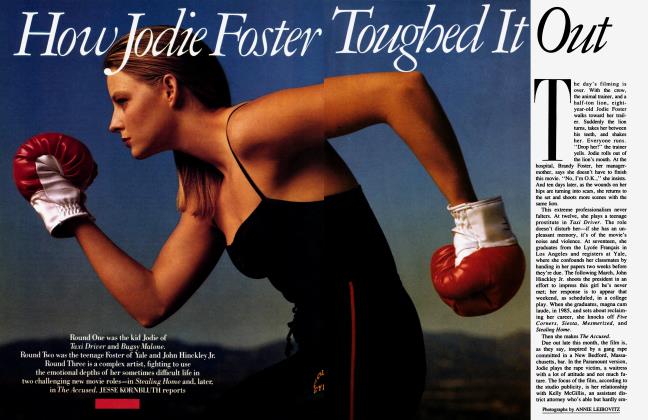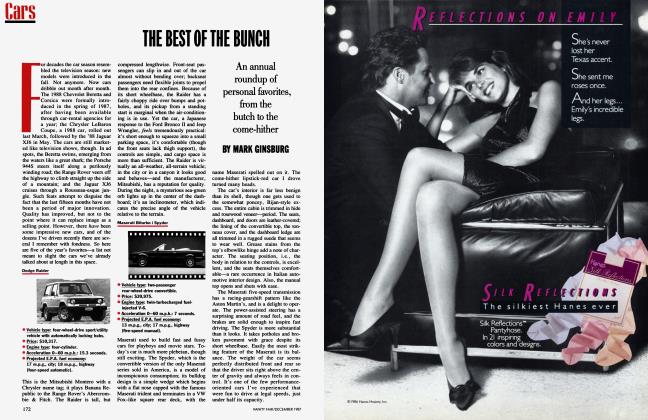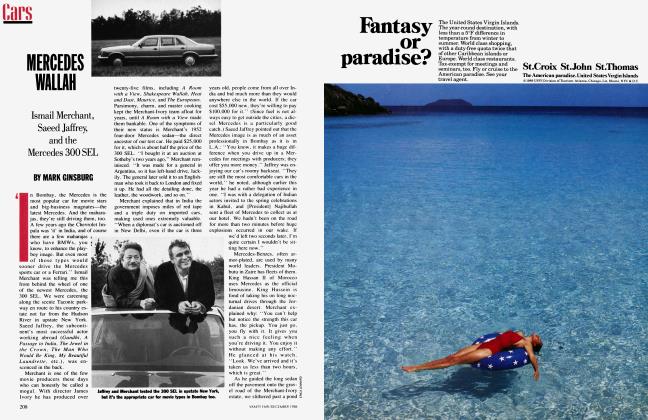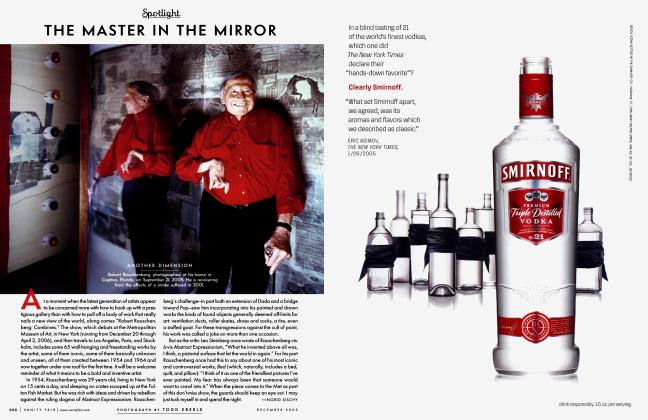Sign In to Your Account
Subscribers have complete access to the archive.
Sign In Not a Subscriber?Join NowTOYOTA AND OATES
Cars
Rock star John Oates drives the new Toyota Celica All-Trac Turbo
MARK GINSBURG
'The first car I ever drove was a Renault Dauphine, with two horns, that my parents bought. I had just got my license," recalled singerguitarist-former racecar driver John Oates, of the rock duo Hall and Oates. ''After removing the exhaust pipe, the car was really loud. Then my friend and I would drive backwards from town to town around where we lived in Pennsylvania. We'd also do a thing where one of us would sit in the backseat and steer, and the other one would crouch down in front and work the pedals, so it would look like no one was driving!... But the silliest thing I ever did was to sell my red 1977 Porsche Turbo Carrera, a very beautiful car. I don't have much use for exotic cars, since I'm away from home so often. The Porsche would sit in a garage in the city, and it would worry me; it was always in the back of my mind. I didn't trust anyone else to drive it. And I sold it, which I regret. Now I have a '55 Chevy convertible, which I love and which I'd always wanted. I own a 1984 Porsche 911 Carrera, which is a great all-around sports car, and I can get my kicks driving that. For basic transportation, I use a 1986 Saab 900 Turbo, and my wife drives a Jeep Cherokee." Much of John's driving is a commute between his West Village apartment in Manhattan and a country home in the Connecticut hills two hours away. Just before the start of the current Hall and Oates tour, we added yet another car to his stable for a few days: a bright-red Toyota Celica All-Trac Turbo. ''All-Trac Turbo" means that the turbo-boosted engine supplies power to all four wheels. It transfers power to the axle with the best available traction, ensuring optimum acceleration and handling. This is especially useful in inclement weather.
''The All-Trac's nice, but it's very heavy," John said one summer day, sitting on the porch steps of a rustic wooden building at the foot of a hill. This section of his unpretentious Connecticut estate contains a two-car garage, an indoor swimming pool, and a recording studio. "I'm comparing it to my father's Celica GTS, which is a great little car. This one is about five hundred pounds heavier, and even though it has substantially more power, the weight really costs. It's a smooth-running car, a deceptive car. When you're on the highway, you realize that you're starting to move very fast in the midrange; the gear ratios are well suited for midrange power." (This is useful for passing cars quickly.) "It's not that fast off the line," he continued. "It's a cruiser, not a sprinter. Last night on the highway it was hard to keep the speed down, because it just wants to go. But I do think a good set of tires—Yokohamas, Goodyears, or B. F. Goodrich Comp T/A's— would really improve the handling. You don't even notice that it's a four-wheeldrive until you're on a slow comer and then give it some power. The drivetrain is sophisticated, quiet, and supple, with no vibration. But the gearshift linkage is the cable type, and it's balky. I was surprised; it doesn't seem like something the Japanese would let get by. With Hondas, the shift mechanisms are flawless."
Though the Celica All-Trac can seat four, it's really a two-seater. The sheer weight of the vehicle gives one a sense of security: the heaviness of the transmission hardware slows the car down, but the engine's turbocharger speeds things up with very little lag, unlike John's Saab 900 Turbo, which skips a few beats before the rush of power. The weight also helps prevent the car from drifting at higher speeds, though more effort is needed to turn the steering wheel in tight parking maneuvers (unless one revs up the engine to boost the power assistance). John's remark about the five-speed manual transmission's being balky and notchy, rather than being characterized by light, crisp, easy throws, has been widely echoed by auto enthusiasts. Shifting did require a little bit of effort—it wasn't silky-smooth, but this helped the All-Trac feel like a real sports car. The anti-lock disc brakes were superb.
"Every family sedan in America should have four-wheel drive and antilock brakes as standard equipment," John said, rising from the porch. "The added safety warrants it, and the technology is available. I've made this trip from New York to Connecticut twice a week, every week, for a few years now, and there's always bad weather in the winter: slush, snow, and rain. I'd love to have the All-Trac then—I'm sure it would really show its stuff. ' ' John lifted the hood. "The engine is packed in, no doubt about it, yet once I started the car, the temperature gauge never wavered. When I drive my Saab in warm weather, the needle really moves up there, then the electric cooling fans come on and blow constantly. It's the first time I've seen extra support struts in a production car; they used to put them in racing cars all the time. It makes the torsion more rigid—less flex—and stiffens up the front end of the car. There's a lot of power going to those wheels.
"The interior is laid out very well," John added, hopping inside. "I love the seats: the electric lumbar support and side bolsters are great. I found a comfortable position right away, without any fiddling around—though a lot of adjusting can be done if you need it. And I like the dead pedal to the left of the clutch; it's a place to rest your foot. " The thick, leather-wrapped steering wheel tilts and telescopes; it's standard equipment, along with power windows and power door locks. The gauges are analog and easily readable, though housed in a vinyl-covered dashboard embellished with simulated stitching. Exterior and interior panels were commendably flush, and the paint job—John called it "arrest-me red"—was finely finished.
"It's a good car, but the styling's not for someone who's insecure," said Oates, who leaves his Porsche in the country and drives the Saab in Manhattan because he prefers to be inconspicuous. "If you want to make a statement, this isn't the car to do it in. Basically, Toyota has taken a moderate family coupe and added all the performance and technology to it. It's understated, and hard to distinguish from a normal Celica, although if I spotted this car on the road, since I know what it is, I'd be checking it out—it appeals to real autophiles." John felt that the Celica GTS model, which he urged his father to buy and which has run flawlessly, was a bargain. At $20,700, is its stablemate a good value? "I think the All-Trac Turbo is a value, but it's in an odd place in the market," he observed. "Toyota's priced it between the Porsche 924 and anything else you can buy for the money" (e.g., Mustang GT, Pontiac Trans Am, Honda Prelude). "Yet the performance leans toward the 924 realm, and surpasses that of the Audi Quattros, which cost more. It should sell, because it's worth it."
'When I first got into the All-Trac, I was being very analytical," John concluded. "The Friday night I drove up to Connecticut, and the following morning when I thrashed it around the country roads, I was forming impressions and thinking about the car. Then, on Sunday night, I had to drive a friend back to the city to catch a plane, so we had to leave at rush hour. All of a sudden I wasn't thinking about the car anymore—I was just driving it. We were talking and listening to the radio in traffic on the Saw Mill River Parkway, and then the West Side Highway. After I put it into the garage, I realized I had made the journey just as quickly as I do in my usual car, but I was much less fatigued, much more comfortable driving at the speeds I like to drive. It was effortless. When I got out of the All-Trac, I realized how impressive it was."
'While Oates tours with Daryl Hall for the next year and a half, promoting their Ooh Yeah! album, his Porsche 911 will be up on blocks with its fluids drained. Come winter, the Chevy will go into storage as well. We spoke about car collecting, and he pointed out that 1960s muscle cars—such as the Boss Mustang, the Judge Pontiac GTO, and the Olds 442—were appreciating rapidly. He cited the All-Trac Turbo to make his case: "Here you have a refined, high-tech, efficient car that does everything well; what it lacks is sensuousness. There's a visceral feel that you just don't get from the car. I think with the muscle cars you had the epitome of the exact opposite: totally visceral, mostly crude, seat-of-your-pants.... To me, as cars get active suspension and all the electronics, as they evolve to that stage, the cars of the sixties are going to represent the culmination of an era, the end of an era. Nevertheless," he added after a pause, "I have to say that I'm sorry to have to give the All-Trac back to you."
MANUFACTURER'S SPECIFICATIONS: Toyota Celica All-Trac Turbo
• Vehicle type: all-wheel-drive, four-passenger liftback coupe.
• Estimated price: $20,700.
• Options: air-conditioning, $960; anti-lock brakes, $1,100.
• Engine type: twin-cam, sixteen-valve, turbocharged two-liter four-cylinder.
• Acceleration 0-60 m.p.h.:
7.1 seconds.
• Estimated top speed: 135 m.p.h.
• Projected E.P.A. fuel economy: 19 m.p.g., city;
26 m.p.g., highway.
 View Full Issue
View Full Issue


















Subscribers have complete access to the archive.
Sign In Not a Subscriber?Join Now